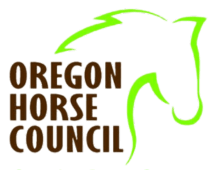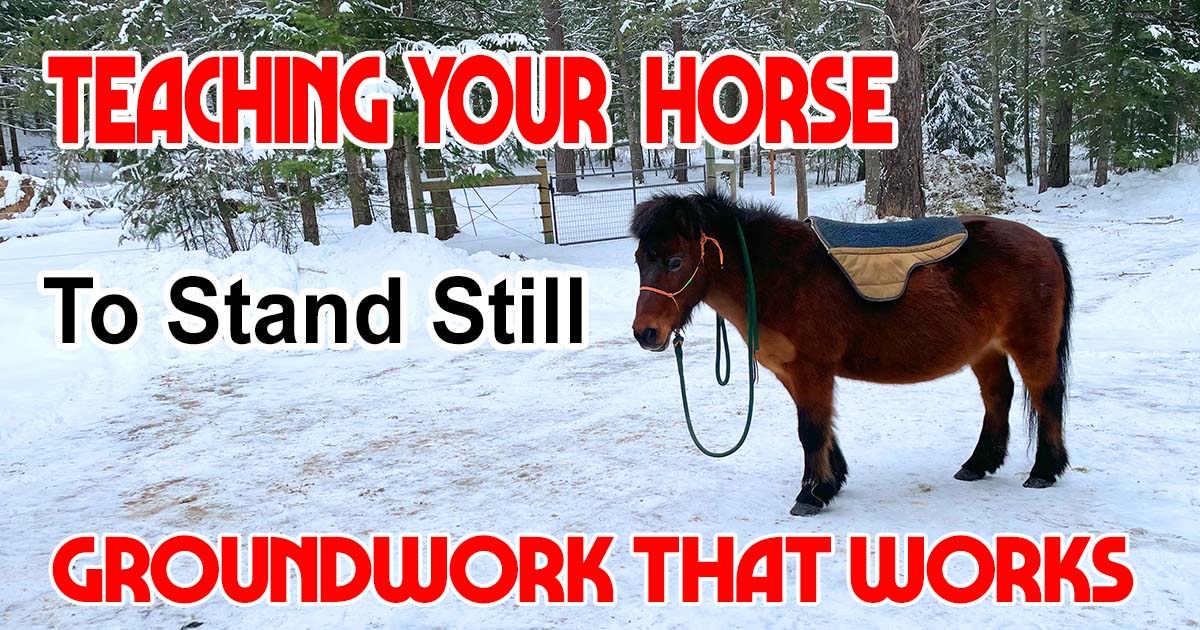To go someplace, first you must stand still.
Can you park your horse? I often park my animals without tying them. Asking them to stay in one place isn’t too much to ask. One of the first skills that we work on is standing quietly. Here’s how we work on whoa when teaching your horse to stand quietly.
Standing still
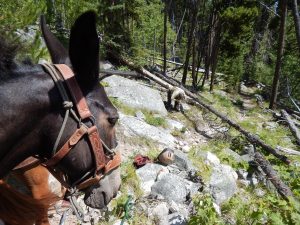
Whether it’s stepping away from your horse to grab something from the tack room or simply standing still while clearing a branch from the trail, standing still and calm is one of the skills that make for a good horse. When we’re at home, my goal is to be able to have my animals stand quietly untied while grooming, tacking up, or loading pack saddles. My feeling is that if my animals can calmly standstill as I’m walking around the barn, they’ll be that much better while at a trailhead with all sorts of activity and commotion around them. I want my animals focused on me, not whatever else is happening around them.
Start working towards your goal of teaching your horse to stand quietly with a simple exercise. I stand in front of my horse as I stand at the end of the lead rope facing him. I let the body of the lead lay on the ground and say, whoa. Then wait. Of course, there’s a little more to it than that; here’s how I break it down.
The Gear
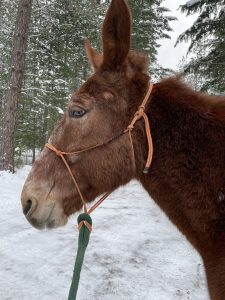
I prefer to use a rope halter and long-ish lead for this exercise. The rope halter provides targeted pressure that I can instantly release. A longer lead rope allows me to gradually increase my distance from the horse as we progress in our training. Tie the lead to the halter when you’re learning instead of using a metal snap. I want the knot to annoy my horse; I don’t want to hurt him.
The Process
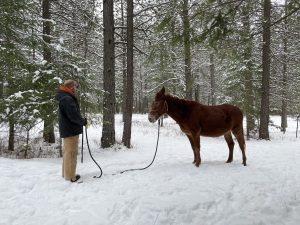
Once you have your horse and equipment sorted, hold the lead in your hand and turn to face the horse. I like to stand as far away as I can, but in the beginning, that may be only 4-5 feet of distance; that’s ok. Now ask him to stand still with a “whoa.” The cues your horse will latch on to are turning to face the beast and the verbal “whoa.” I think of turning to face the horse as my preparatory command and the verbal cue as the command of execution.
Once you’ve said “whoa,” wait. As soon as the horse moves a leg, give the rope life by shaking it vigorously. This is the same signal for backing up, and as soon as the horse is back in the original spot, stop. As soon as the horse is where he started, immediately drop the lead so that the rope’s body is on the ground and lifeless.

Immediate and instant corrections and cessation of those corrections are paramount. The quicker you catch an attempt at movement, the better your horse will understand what he did wrong. The prompt release of pressure when he’s where he should be lets him know he did well. The amount of shaking required will become dramatically less over time as you and your horse work on this exercise. Eventually, you may merely have to pick up the lead or just give him a look, and any fidgeting will cease. Repeat.
Standing still is a skill that we work on continuously. Over time you’ll find that the horse will stand quietly for longer and longer without moving away. As you, and your horse, get better with this skill, you’ll notice that your horse is watching and focusing on you and won’t walk off until you give him the ok.
Increase the Challenge
To build the wait duration, we keep working for longer and longer periods of standing quietly. At first, we may only last for several seconds without a correction and aim for a few more seconds on the next try. The beauty of these standing exercises is that you can do them practically anywhere.
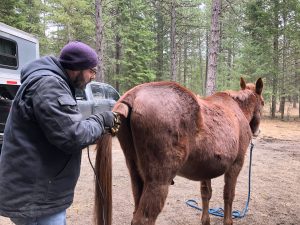
Once your horse has developed the patience to stand quietly for a few minutes with you nearby, it’s time to increase the challenge by dropping the lead line. That’s right, let it go. Take a few steps away and see what happens. If he should move, a sharp “whoa” should stop him. If it doesn’t, just grab the lead and put him back in his original location. Repeat. Gradually build on this by walking further and staying away more extended periods. Congratulations, you’ve got a horse that ground ties.
Practice
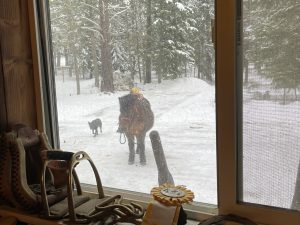
Practice these exercises constantly, both at home and on the trail. I expect my animals to stand still at home while I groom them, saddle them, and load their packsaddles. Indeed, it’s my feeling that if my critters cannot stand still for grooming and saddling without being tied, then they’re not ready for more advanced endeavors such as trail riding. I’ll often count on my riding animal to stand quietly while I clear downfall or adjust a pack load on the trail. Yes, that’s me taking a chance on a long walk, but I’ve developed that confidence over many years with these critters. Building a horse that trusts you as his herd leader and will do as you ask takes time and effort. There are no shortcuts.
For more of my thoughts on trail riding and camping with horses, as well as the world’s most comprehensive guide to horse trails and camps, please give us a visit at www.TrailMeister.com. You can also find more information in the best-selling book “The ABCs of Trail Riding and Horse Camping – Essential Knowledge for Trail and Camp.” You can find more info on the book here: https://amzn.to/3CuErid
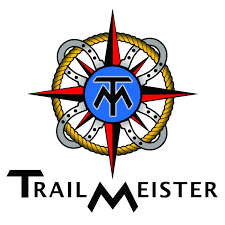
TrailMeister is the world’s largest horse trail and camp guide. With all of the info that you need on thousands of horse trails and camps across the US and Canada.
